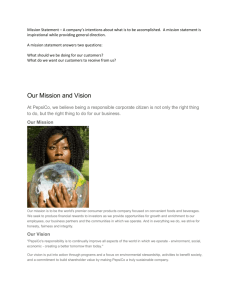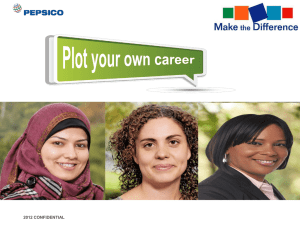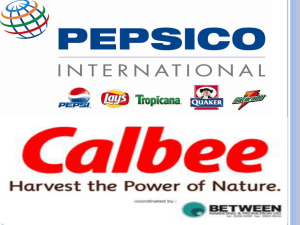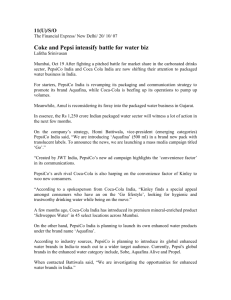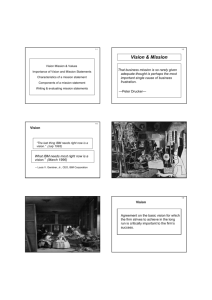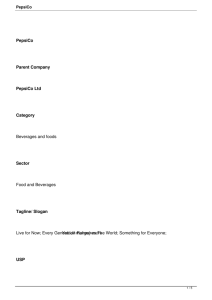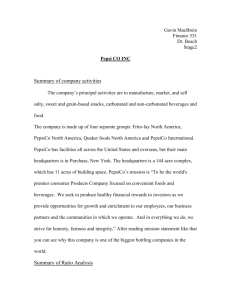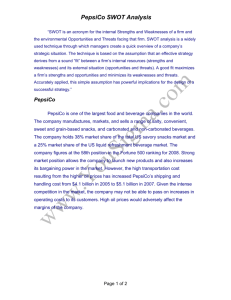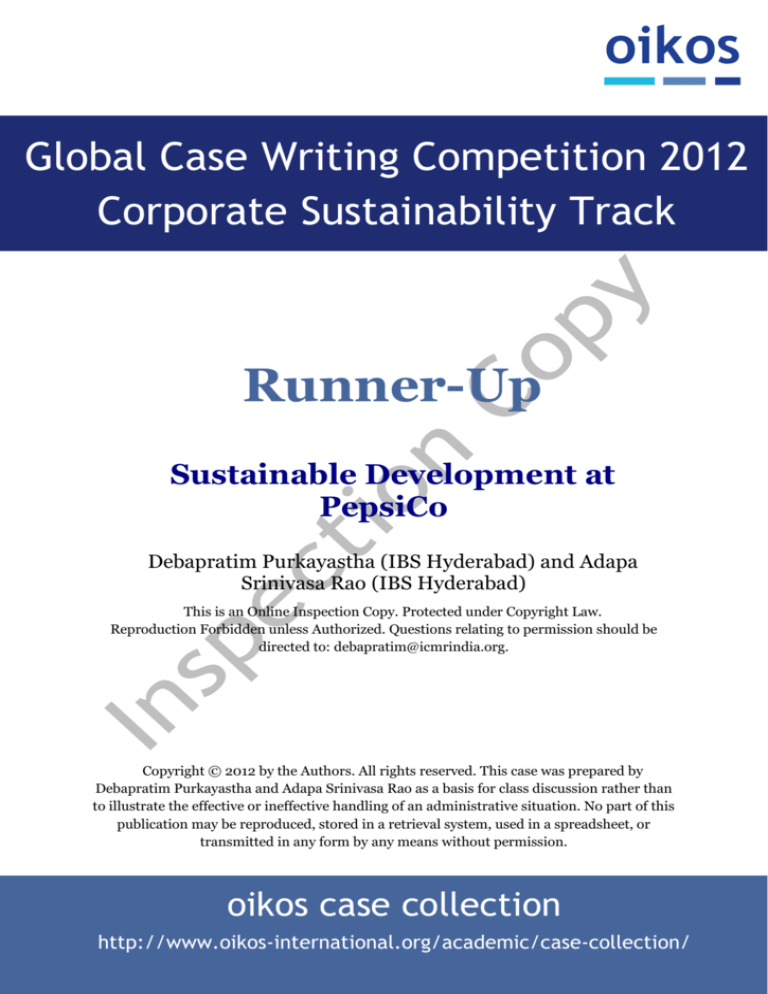
Global Case Writing Competition 2012
Corporate Sustainability Track
Runner-Up
Sustainable Development at
PepsiCo
Debapratim Purkayastha (IBS Hyderabad) and Adapa
Srinivasa Rao (IBS Hyderabad)
This is an Online Inspection Copy. Protected under Copyright Law.
Reproduction Forbidden unless Authorized. Questions relating to permission should be
directed to: debapratim@icmrindia.org.
Copyright © 2012 by the Authors. All rights reserved. This case was prepared by
Debapratim Purkayastha and Adapa Srinivasa Rao as a basis for class discussion rather than
to illustrate the effective or ineffective handling of an administrative situation. No part of this
publication may be reproduced, stored in a retrieval system, used in a spreadsheet, or
transmitted in any form by any means without permission.
oikos case collection
http://www.oikos-international.org/academic/case-collection/
oikos Global Case Writing Competition 2012
Runner-Up
Sustainable Development at PepsiCo
“Great companies are built to succeed today, tomorrow, and well into the future. Our
commitment to balancing excellent operating performance with sustainable business
practices is a big reason PepsiCo has become one of the world’s top performing food and
beverage companies.” i
– Indra Nooyi, Chairman and CEO of PepsiCo, in September 2011
Since mid-2011, PepsiCo’s Chairman and CEO, Indra Nooyi (Nooyi), had been facing some
difficult questions. During the first five years of her tenure at the helm of the consumer
packaged goods major, Nooyi had been credited with transforming PepsiCo by spearheading
the company’s sustainable development journey with her ‘Performance with Purpose’
strategy. But since mid-2011, she had been facing criticism that this had come at the cost of
marketing and positioning of PepsiCo’s products to boost sales.
Faced with environmental and social criticism, PepsiCo started an ambitious new sustainable
development program called ‘Performance with Purpose’ in 2009. The five-year mission was
based on the philosophy that that the organization should not only keep focus on financial
performance but also on its responsibilities. The new program listed 47 commitments that
PepsiCo had toward society and these came under four broad areas: Performance, Human
Sustainability, Environmental Sustainability, and Talent Sustainability. The first
commitment was to its shareholders to give good returns for their investments while the
others were to its other stakeholders. PepsiCo took several steps to fulfill its commitments. It
increased the content of fruits, vegetables, nuts, grains, and low-fat dairy in its global
product portfolio. It achieved a positive water balance in India where it had been involved in
controversies regarding the use of groundwater for its operations. It introduced several
affordable and nutritious products for the underprivileged sections of society and reduced
the use of electricity and fuel for its operations. It also undertook several steps to increase the
diversity of its workforce around the world. For the year 2011, PepsiCo was named the top
food and beverage company in the DJSI Food and Beverage Super sector and was included in
the Dow Jones Sustainability Indexes 1. ii PepsiCo was the only company based in the US to
earn the top ranking in the 19 super sectors assessed for the year 2011. This was the third
consecutive year that the company had been named the leader in the beverage sector. The
top ranking achieved by PepsiCo was the result of its focus on sustainable development
practices around the world, according to some analysts.
However, with PepsiCo’s flagship cola brand Pepsi being relegated to the #3 position in the
US market behind arch-rival The Coca Cola Company’s 2 (Coca Cola) Coke and Diet Coke, key
1
2
Dow Jones Sustainability indexers are a group of indexes which evaluate the world’s leading companies in
their sustainability practices.
The Coca Cola Company, headquartered in Atlanta, Georgia, US, is a maker of non-alcoholic drinks. It is best
known for its flagship product Coke. Its revenue and profit for the fiscal year 2010 were US$ 35.12 billion and
US$ 11.81 billion respectively.
Purkayastha/Srinivasa Rao
Sustainable Development at PepsiCo
1
oikos Global Case Writing Competition 2012
Runner-Up
stakeholders such as shareholders and bottlers had begun to question Nooyi’s focus. They
contended that her philosophy had also led her to back ‘Pepsi Refresh’ and socialresponsibility positioning of the same kind and that this had cost the company in terms of
the sales of the products themselves. In addition to this, they felt that the company’s
revamped food product lines had produced mixed results. Moreover, despite all the
measures taken under the new sustainable development program, PepsiCo still continued to
face criticism from certain quarters regarding the social and environmental impact of its
business practices.
COMPANY BACKGROUND
The origins of Pepsi date back to the late 19th century when a young pharmacist Caleb
Bradham (Bradham) started selling a refreshing drink called ‘Brad’s Drink’ in his pharmacy.
The drink was later renamed Pepsi-Cola after the digestive enzyme pepsin 3 used in the
recipe. The sales of Pepsi soon started to increase. This convinced Bradham to form a
company called the Pepsi-Cola Company. Bradham got an official patent for the drink in
1903 and then started to sell it in bottles. The business showed spectacular growth and
Bradham sold 7,968 gallons of the drink in the year 1903. He later started to award
franchises to grow his business and the Pepsi-Cola Company’s franchisees spread to 24
states of the US. The strong franchise system developed by Bradham was one of the main
reasons for Pepsi’s initial success. The sales of Pepsi also reached 100,000 gallons by 1910.
The outbreak of World War I, however, affected the company’s business due to fluctuations
in the price of sugar. It went bankrupt by the year 1923. Bradham sold the Pepsi-Cola
trademark to Craven Holdings Corporation and resumed his pharmacy business. Pepsi Cola
Company was declared bankrupt for a second time in the year 1931 as the Great Depression4
affected its sales.
Pepsi’s fortunes changed when its assets were purchased by a successful candy manufacturer
Charles G. Guth (Guth). Guth had been thinking of selling his own soft drink at his stores
after Coca Cola declined to give him a discount on its drinks. He reformulated the Pepsi
formula and started to sell it in 12-ounce bottles at a cheaper price than its competitors.
Under Guth’s leadership, Pepsi grew to be a national brand once again. The Pepsi-Cola
Company started to expand into international markets like the Soviet Union, Latin America,
and Canada. After the end of World War II, Pepsi-Cola Company’s international
headquarters were moved to Manhattan and it continued to expand further into
international markets. In 1964, it introduced some other successful soft drinks to its product
portfolio like ‘Diet Pepsi’ and ‘Mountain Dew’. iii
Pepsi-Cola Company and Frito-Lay, the world’s largest maker of snack chips in the world,
were merged in the year 1965 to form PepsiCo Inc. (PepsiCo). PepsiCo soon started to
diversify into the restaurant business to generate faster growth for the company. It
purchased Pizza Hut in 1977, Taco Bell in 1978, and Kentucky Fried Chicken in 1986. With
3
4
Pepsin is an enzyme released by the cells in the stomach. It degrades the food proteins into peptides.
The Great Depression was a worldwide economic depression that started in 1929 and lasted till the late 1930s.
Purkayastha/Srinivasa Rao
Sustainable Development at PepsiCo
2
oikos Global Case Writing Competition 2012
Runner-Up
these takeovers, PepsiCo emerged as the world leader in the restaurant business. PepsiCo’s
operations were split in 1986 with the beverage operations being combined under PepsiCo
Worldwide Beverages and snack food operations under PepsiCo Worldwide Foods. In 1986,
PepsiCo purchased 7-Up International, the third largest franchise soft drink outside the US.
By 1990, PepsiCo’s revenues had reached US$ 17.80 billion and it was ranked in the top 25 of
the Fortune 500 5 companies. Its revenues further increased to US$ 30.42 billion by the year
1995 and it became the world’s third largest employer. But, the company’s performance had
deteriorated by the year 1996, both in the domestic and international markets due to intense
competition from Coca-Cola. For the year 1996, the beverages division of PepsiCo posted an
operating profit of just US$ 582 million. Many analysts felt that the main reason for
PepsiCo’s decline in performance was its diversification into the restaurant business. Many
other restaurant chains were also not willing to offer PepsiCo’s products in their outlets as it
owned a restaurant business which directly competed with them. So PepsiCo decided to
restructure its business and spin off its restaurant business as an independent publicly
traded company called Tricon Global Restaurants, Inc. The spin-off was completed in
October 1997. Tricon was later renamed Yum! Brands Inc. in the year 2002. PepsiCo decided
to focus on its packaged foods business to effectively compete with Coca Cola. It also
acquired Tropicana, the world’s biggest producer of branded juices, in July 1998. Other steps
taken by PepsiCo included hiving-off of its bottling operations into a separate new company
called Pepsi Bottling Group (PBG). The restructuring efforts paid off and its operating profits
rose from US$ 2.58 billion for the year 1998 to US$ 3.23billion in 2000. In the year 2000,
PepsiCo acquired Quaker Oats, a food conglomerate. The acquisition was aimed at offering
healthier alternatives to its consumers. The new acquisition was aimed at capturing a new
trend among the consumers who were abandoning carbonated drinks in favor of bottled
waters, herbal teas, and juice drinks.
CONTROVERSIES SURROUNDING PEPSICO
Despite its spectacular turnaround, PepsiCo started facing criticism regarding the effect of its
operations on the environment. In the early and mid-2000s, it faced controversies regarding
the usage of water for its bottling operations which reportedly caused water shortages in
some parts of India and the US. In India, PepsiCo faced controversies regarding its usage of
water as water shortages were getting acute in the country due to the rapid increase in
population. PepsiCo was accused of diverting water which could be used for drinking
purposes for making its beverage products. Critics said PepsiCo’s excessive reliance on
groundwater for making its products had resulted in a shortage of drinking water in the
areas in which it operated. Activists from 13 Indian states launched a campaign against
companies such as PepsiCo for exploitation and pollution of groundwater. Commenting on
the business practices of beverage companies, a prominent social activist said, “Coke and
Pepsi are engaged in a water war against India. Their bottling plants are stealing millions of
liters of water, denying local communities their fundamental right to water.” iv
5
Fortune 500 is the list of top 500 US companies published by the Fortune magazine.
Purkayastha/Srinivasa Rao
Sustainable Development at PepsiCo
3
oikos Global Case Writing Competition 2012
Runner-Up
In 2003, the village council of Pudussery, a village in the south Indian state of Kerala,
revoked the water-use license of a bottling plant of PepsiCo, alleging that its operations in
the area had resulted in water shortage in the village. v But Pepsi denied that its operations
had led to depleting water resources in the areas. However, it accepted that it depended on
groundwater for its bottling operations. vi PepsiCo along with Coca Cola faced the wrath of
judiciary when the High Court of India’s southern state Kerala criticized them and
commented that, “(ground) water belongs to people, not to Coke and Pepsi....” vii PepsiCo
faced similar allegations over its usage of groundwater in some areas of the US where it had
its bottling operations.
PepsiCo also faced criticism from activist groups regarding the effect of its products on the
health of its consumers. In 2006, PepsiCo faced a huge controversy in India when the Center
for Science and Environment (CSE), a public interest research and advocacy organization
based in India, alleged that the level of pesticides in its soft drinks exceeded the safety
standards prescribed by the regulatory bodies. PepsiCo refuted the allegations saying that
the pesticide residuals found in its beverage products were within the limits prescribed by
the concerned regulatory body. It said that it followed the same quality standards in India
that it followed across the globe. Commenting on the controversy, Nooyi said, “For
somebody to think that Pepsi would jeopardize its brand — its global brand — by doing
something stupid in one country is crazy.” viii
PepsiCo questioned the CSE report and the data gathering techniques employed by the
organization. The Government of India stood by PepsiCo. But Kerala temporarily banned the
sales of beverage products made by PepsiCo. ix Several other Indian states too banned the sale
of PepsiCo’s products in government-run schools and colleges. x The High Court of Kerala
later lifted the ban which, was subsequently upheld by India’s Supreme Court subsequently. xi
The sales of PepsiCo’s products came down drastically. Analysts said that more than the
sales, it was the reputation of PepsiCo and the other beverage companies that had taken a
beating due to the controversy.
Another controversy that PepsiCo was involved in was with regard to the contents of its
snack and beverage products, which critics said, led to an increase in health problems like
obesity and diabetes. Critics said that PepsiCo was not focusing on making healthy low
calorie products but was expanding its product base in the high calorie segments. PepsiCo
also faced the wrath of activist groups with regard to the effect its products were having on
the health of children. Activist groups accused PepsiCo of marketing products with high
calorie contents to children, leading to health risks at a younger age. Some research directed
at junk food found that repetitive advertisements targeted at children could influence their
purchasing decisions towards high calorie junk food. xii
Some other controversies faced by PepsiCo were the impact that the contents used in
manufacturing and packaging its products were having on the environment. Its beverage
products were packed in plastic bottles and tin cans, which environmental activists alleged,
could cause environmental pollution. Other companies in the beverages and snacks sector
such as CocaCola also faced similar controversies. In 2003, Coca-Cola was accused of
dumping the waste generated in its bottling plants as fertilizer on farmers. In a study
Purkayastha/Srinivasa Rao
Sustainable Development at PepsiCo
4
oikos Global Case Writing Competition 2012
Runner-Up
conducted by BBC’s Radio 4, it was found that Coca Cola had supplied wastes from its
bottling plant in Kerala to farmers as fertilizer. These contained dangerous toxic metals like
cadmium and lead. xiii When cadmium entered the human body, it slowly accumulated in the
kidneys and caused kidney failure. Lead could cause mental retardation and anemia. The
study was conducted by BBC on the basis of complaints received from local people about
groundwater levels becoming depleted due to Coca Cola’s operations in that area.
SUSTAINABILE
PEPSICO
DEVELOPMENT
PRACTICES
OF
PepsiCo has overtaken its archrival Coca Cola in 2005 and has grown to nearly twice the size
of the latter. For the year 2010, Coca Cola’s revenues stood at US$ 35.12 billion while that of
PepsiCo stood at US$ 57.84 billion (Refer to Exhibit-I for the consolidated income statement
of PepsiCo from 2006-2010). PepsiCo’s tremendous growth was possible because of a shift in
its focus from the beverages business and the mergers and acquisitions it has undertaken in
the 1990s and later. After overtaking Coca Cola in terms of revenues, PepsiCo decided to
focus on corporate sustainability to differentiate itself from Coca Cola. The growth in its
business led to more controversies regarding its operations.
In the face of growing criticism, PepsiCo started to focus more on sustainable development
practices worldwide. It started a new sustainable development program in 2009. The
program was started with a five-year mission ‘Performance with Purpose’ under the
leadership of Nooyi, who took charge as CEO in 2006 (Refer to Exhibit- II for the
performance with purpose mission of PepsiCo). The India-born Nooyi was a graduate from
Madras Christian College in Chemistry, Physics, and Mathematics, and a Management
graduate from the Indian Institute of Management, Calcutta. She also had a Master’s in
Public and Private Management from Yale. After stints with companies such as ABB6,
Johnson and Johnson 7, and Management consulting firm Boston Consulting Group, she
joined PepsiCo as chief strategist in 1994. She served as the Senior Vice-President of
Strategic Planning and Development and Chief Financial Officer of PepsiCo before becoming
CEO.
The ‘Performance with Purpose’ mission was based upon the belief that the financial
performance of the organization must go hand-in-hand with its responsibilities toward
society and the environment. The declaration by PepsiCo called the ‘The Promise of PepsiCo’
had 47 commitments which would guide the organization for the following decade. xiv (Refer
to Exhibit - III for PepsiCo’s Goals and Commitments) The ‘Performance with Purpose’
mission constituted both promises made to its shareholders for providing good financial
returns and promises to society and the environment. xv In its promise to shareholders viz.
‘Performance’, PepsiCo vowed to deliver superior and sustainable financial performance to
maximize their wealth. PepsiCo’s responsibilities toward society and the environment were
6
7
ABB is a multinational headquartered in Zurich, with operations in power and automation technology.
Johnson and Johnson is a global American pharmaceutical, medical devices, and consumer packaged goods
manufacturer.
Purkayastha/Srinivasa Rao
Sustainable Development at PepsiCo
5
oikos Global Case Writing Competition 2012
Runner-Up
broadly categorized into three areas viz. Human Sustainability, Environmental
Sustainability, and Talent Sustainability. Human sustainability referred to the efforts made
by PepsiCo to meet the different nutritional needs of the people. Environmental
sustainability focused on protecting the environment and reducing PepsiCo’s reliance on
natural resources and conserving them for future generations. It also focused on mitigating
the impact of its operations on the environment. Talent sustainability focused on developing
its employees by developing the skills required to meet its growth needs and for making
PepsiCo an attractive target for the world’s best brains.
Commenting on PepsiCo’s initiatives in sustainable development, Nooyi said, “The talents
and skills of our global workforce, coupled with our operational capabilities, provide PepsiCo
with a unique opportunity to have a positive impact on society. The goal of our sustainable
development journey is to operate as a force for bringing greater good to the world.” xvi
The new sustainable development program initiated at PepsiCo was part of an overall
realization among many business organizations regarding the strategies to deal with a future
where resources were limited. Commenting on the realization among business organizations,
Jonathan Kaplan, senior policy specialist at Natural Resources Defense Council 8, said, “Food
manufacturers, in general, are closer to recognizing that we’re headed toward a future with
finite resources, where water, grain, and other inputs are less available and more expensive.
Companies that figure out how to become part of the solution will have an advantage.” xvii
PERFORMANCE
As per the Performance promise to its shareholders, PepsiCo made a lot of commitments
regarding the performance of PepsiCo. The Performance promise included growing its
international revenues at a rate which was double the global GDP growth rate. PepsiCo
promised to achieve this through a series of measures. It promised to increase its market
share of the beverage and snack products in the top 20 markets. It also promised to improve
the brand equity scores for PepsiCo’s brands in the top 10 markets. Other measures included
expanding the division operating margins, increasing cash flow in proportion to the growth
in the net income growth, delivering the best possible returns in the industry to its share
holders, and following high standards of corporate governance.
HUMAN SUSTAINABILITY
PepsiCo’s human sustainability initiatives focused on helping people live healthy lives by
offering them a healthy portfolio of products which were also enjoyable. As per the
commitments given by the company with regard to its products, PepsiCo promised to
increase the content of fruits, vegetables, nuts, grains, and low-fat dairy in its global product
portfolio. It also promised to reduce the amount of sodium, saturated fat, and added sugar in
8
Natural Resources Defense Council, headquartered in New York, USA, is an international environmental
advocacy group.
Purkayastha/Srinivasa Rao
Sustainable Development at PepsiCo
6
oikos Global Case Writing Competition 2012
Runner-Up
its products by 25, 15, and 25 percent respectively. As per its commitments regarding its
marketing practices under human sustainability, PepsiCo also promised to display calorie
count and key nutrients on its product labels, restrict selling some of its products to children
under the age of 12, and eliminate the sale of products which were primarily made of sugar in
all schools around the globe by 2012. PepsiCo said it would invest more in businesses and
research and development activities to produce more nutritious products which were
affordable for the low-income communities around the globe. PepsiCo also proposed to
promote healthier communities by enhancing the diet and physical activity programs. xviii
ENVIRONMENTAL SUSTAINABILITY
Under its environmental sustainability initiatives, PepsiCo promised to be a good citizen of
the world committed to protecting the natural resources by proper use of land, energy, and
packaging in its operations. PepsiCo committed itself to increasing its water use efficiency by
20 percent by 2015. In view of the protests that PepsiCo was facing in countries like India
regarding its water use practices, it promised to strive for a positive water balance in its
operations in areas water was scarce. PepsiCo promised to provide access to safe water to 3
million people living in developing countries by 2015. xix It also promised to use more
recycled material in its packaging operations which would reduce environmental damage.
PepsiCo committed itself to countering climate change by improving electricity use efficiency
by 20 percent by 2015, reducing the fuel used by 25 percent by 2015, reducing the
greenhouse gas (GHG) emissions from its operations, and applying agricultural practices
which had been proven sustainable, in its farmed land. .
TALENT SUSTAINABILITY
PepsiCo’s talent sustainability initiatives were focused on one of its most important
stakeholder communities – its employees. PepsiCo promised to invest in the development of
its associates to improve the skills necessary to drive the company’s growth as well as
improving employment opportunities in the communities it served. PepsiCo aimed at
increasing diversity in its workforce by recruiting people from diverse ethnic backgrounds. It
said that it would be able to properly understand the needs and demands of the local people
by giving better representation to the people where it had operations. It also planned to
improve the engagement with its employees when compared with other big Fortune 500
companies. xx PepsiCo committed itself to supporting education programs in poor countries
through charitable contributions globally. Focusing on the welfare of its employees, PepsiCo
committed itself to improving workplace safety by decreasing lost-time injury rates 9 and
increasing health and safety metrics.
9
Lost-time injury rates refer to an occurrence which results in fatality, permanent disability, or time lost from
work due to injury or disablement.
Purkayastha/Srinivasa Rao
Sustainable Development at PepsiCo
7
oikos Global Case Writing Competition 2012
PEPSICO’S
PROGRESS
DEVELOPMENT
Runner-Up
IN
SUSTAINABLE
PepsiCo made good progress on its promises regarding sustainable development, according
to some analysts. At PepsiCo, the ‘Performance with Purpose’ agenda came from top down.
Nooyi became a prominent advocate of its sustainable development practices. She believed
in the organization’s responsibility toward society and in giving back. This belief in conscious
capitalism made her a leader in implementing the sustainable development programs at
PepsiCo. Another person who was prominent in the implementation of the new sustainable
development program was David Walker (Walker). Walker was a twenty-five year veteran of
PepsiCo and was serving as the director of environmental sustainability. He managed several
programs at PepsiCo and was responsible for PepsiCo’s programs on responsibility toward
the environment.
Sticking to its commitment, PepsiCo made rapid progress in its financial performance. In
2009, when the world economy was still recovering from the great economic recession of
2008, PepsiCo increased its global revenues at a Compounded Annual Growth Rate (CAGR)
of 13.6 percent for the three preceding years. This was well ahead of its target of growing at
double the global GDP growth. In 2010, PepsiCo’s revenues outside the US grew at a rate of
30 percent, which constituted 45 percent of its total revenues. Its businesses in India and
Brazil grew at 2.5 and 3.5 times of their real GDP growth rates. xxiPepsiCo increased its
market share in its top 20 markets by introducing new products like ‘Pepsi Max’ — a zerocalorie beverage — and extending its portfolio into sub-segments. PepsiCo also focused on
increasing its brand equity for its brands in the top 10 markets through some consumer
engagement programs which were very successful. Some of these programs allowed the
consumers to give their opinions on the new flavors introduced by the brands.
PepsiCo acquired some of its bottlers in North America and Europe which helped it to reduce
its overall division operating margins in 2010. Its cash flow for the three years ended 2010
increased more than its growth of net income and it increased its annual dividend in 2010 by
7 percent from US$ 1.80 to US$ 1.92. This was the 38th consecutive year for which PepsiCo
increased its revenues.
PepsiCo made great strides in increasing the content of fruits, vegetables, nuts, grains, and
low-fat dairy in its global product portfolio (Refer to Table I for food portfolio of PepsiCo).
Its Quaker division’s contribution of whole grains to the American diet was 500 million
pounds for the year 2010. As part of its human sustainability initiatives, PepsiCo formed the
Global Nutrition Group to increase the ‘Good for You’ foods and Beverages in its product
portfolio. PepsiCo’s ‘Good for You’ product portfolio delivered revenue of US$10 billion for
the year 2010 and it had plans to increase it to US$ 30 billion by 2020. In December 2010,
PepsiCo acquired 66 percent of Wimm-Bill-Dann Foods, Russia’s leading branded food-andbeverage company, for US$3.8 billion to bolster its nutrition portfolio. This increased the
company’s annual global revenues from nutritious and functional foods from approximately
US$10 billion to nearly US$13 billion. xxiiPepsiCo continued its efforts to reduce the amount
of sodium, saturated fat, and added sugar in its products as per the targets that it had set. It
continued to invest in developing different salt crystal shapes which would help deliver good
Purkayastha/Srinivasa Rao
Sustainable Development at PepsiCo
8
oikos Global Case Writing Competition 2012
Runner-Up
taste using less sodium. Though it was tough to develop products which had less sugar,
PepsiCo entered into partnerships with other organizations for developing an all-natural
sweetener which would eventually replace sugar.
Table I:
Food Portfolio of PepsiCo Inc.
Fun for You
These products are a part of PepsiCo’s core food and beverages
business. They include Pepsi Cola, Mirinda, Doritos, Lays, Cheetos,
Mountain Dew, 7Up, and Red Rock Deli Potato Chips.
Better for You
These products are foods and beverages that have levels of total fat,
saturated fat, sodium, and sugar that are in line with global dietary
intake recommendations. They include Lay’s Baked Potato Crisps,
Pepsi Max, Diet Mug Root Beer, Diet Sierra Mist, H 2 OH, Diet Pepsi,
and Propel Zero water.
Good for You
These products offer positive nutrition through inclusion of whole
grain fruits, vegetables, low-fat dairy, nuts and seeds or significant
amounts of important nutrients, while moderating total fat, saturated
fat, sodium, and added sugar. They also address the performance
needs of athletes. They include Quaker Instant Oatmeal, G series,
Tropicana, Nut Harvest, and Naked juice.
* Data as of 2011.
Source: www.PEP.com/Download/PEP_Annual_Report_2010_Full_Annual_Report.pdf
PepsiCo implemented front-of-pack labeling for its products in many countries which
displayed calorie and basic nutritional information. The company developed strict sciencebased criteria which would ensure that only its most nutritious products met the standards
for advertising to children under 12. PepsiCo achieved 100 percent compliance for
advertising standards to children in the US and 98.5 percent compliance for the same in
countries such as India, China, Mexico, and some other countries of the European Union. To
keep its promise of providing low cost nutritious food to the underprivileged sections of
society, PepsiCo launched several initiatives. In India, it launched affordable snacks and
biscuits to tackle iron-deficiency anemia. PepsiCo decided to expand PepsiCo Foundation10
to increase contributions and help people with high disparities in health achieve improved
10
PepsiCo Foundation was the philanthropic arm of PepsiCo. It was responsible for providing charitable
contributions to eligible nonprofit organizations.
Purkayastha/Srinivasa Rao
Sustainable Development at PepsiCo
9
oikos Global Case Writing Competition 2012
Runner-Up
health and nutrition through sustainable programs. PepsiCo increased its contribution from
US$4.2 million in 2006 to US$4.7 million in 2010 to achieve improved health and nutrition
by launching effective and sustainable programs.
The PepsiCo Foundation also developed partnerships with non-governmental and charitable
organizations like ‘Save the Children’ 11 and ‘World Food Program’ 12 to increase its
contributions toward promoting healthier societies. In the year 2010, it created a new arm to
facilitate innovation in the area of nutrition and increase its nutrition businesses called
‘Global Nutrition Group’. xxiii It would have its own CEO and would be responsible for
delivering breakthrough innovation in the areas of fruits and vegetables, grains, dairy, and
functional nutrition. PepsiCo’s Chief Scientific Officer Mehmood Khan, who was a key
person in its implementation of sustainable development program, was named CEO of the
new group. Commenting on the creation of the new ‘Global Nutrition Group’, Nooyi said,
“The creation of this Global Nutrition Group is part of our long-term strategy to grow our
nutrition businesses from about US$10 billion in revenues today to US$30 billion by
2020.” xxiv
On the environmental front, in view of the criticism it faced in water use, PepsiCo reduced
the water-use intensity by 19.5 percent by the third quarter of 2010 and nearly achieved its
target of improving its water-use efficiency by 20 percent per unit of production by 2015. It
achieved a positive water balance in its Indian operations by 2009. PepsiCo also started to
have watersheds in China, Mexico, Europe, India, and the US to replenish the water used for
its operations. The PepsiCo Foundation had invested US$15 million for water projects since
2005 and expected to provide safe drinking water to one million people by the end of 2011
and to three million people by 2015. xxv PepsiCo launched a new initiative called the Dream
Machine recycling initiative to increase the beverage container recycling rate from 38
percent in 2009 to 50 percent by 2018. It planned to enter into partnerships with
organizations to establish recycling systems and encourage consumers to recycle. In March
2011, PepsiCo introduced a new beverage bottle which was fully recyclable and made of
plant-based materials. xxvi With an eye on warding off further controversies, the company
made sure that the new material used to make beverage bottles did not compete with food
crops to ward off further controversies.
PepsiCo increased its electricity-use efficiency by 9 percent and fuel-use efficiency by 12
percent by the third quarter of 2010 compared to the 2006 baseline. To reduce the GHG
emissions from its operations, it invested in electric-powered delivery trucks which emitted
75 percent less greenhouse gases. PepsiCo launched the ‘Global Sustainable Agriculture
Policy’ in the year 2009 to encourage everybody to protect and nourish land and
communities. PepsiCo launched an important initiative in 2010 with some British farmers to
reduce carbon emissions and water use by 50 percent over five years. It developed a new
11
12
Save the Children founded in London, UK, is a non-governmental organization that enforces children’s rights
and provides relief and support to children in developing countries.
The World Food Program, headquartered in Rome, Italy, is a branch of the United Nations and provides food
aid around the world.
Purkayastha/Srinivasa Rao
Sustainable Development at PepsiCo
10
oikos Global Case Writing Competition 2012
Runner-Up
precision farming technology in partnership with Cambridge University 13 called ‘i-crop’ to
produce more output utilizing less water. In India, PepsiCo started teaching sustainable
agricultural practices to farmers and helped farmers to form themselves into cooperatives.
To promote environmental education, PepsiCo’s ‘Green Volunteer Organization’ inspired
associates around the world to voluntarily raise awareness regarding eco-friendly practices
both at work and at home.
In 2011, PepsiCo announced that it was planning to launch global ethical-farming standards
to promote sustainable agriculture. The initiative was aimed at putting an economic value on
the impact that its supply chains were having on the environment and society. xxvii The
initiative would focus on resource management, farm productivity, preservation of soil
fertility, and social impacts like effects on farming communities, human rights, and
compliance with local laws where it was operating. Dan Bena, PepsiCo’s director of
sustainable development, said apart from helping PepsiCo in improving its supply chain
management, the new initiative aimed at helping other businesses to measure and monitor
the impact their supply chains were having on the environment. In 2011, PepsiCo signed a
memorandum of understanding with China’s Ministry of Agriculture to promote sustainable
farming. The new partnership with the government of China was part of PepsiCo’s focus on
investing in sustainable agriculture projects. xxviii
To improve diversity and inclusion (D&I) in the organization, PepsiCo took steps to include
D&I as a part of its culture. It took care that its D&I activities were supported at every level of
the organization. In 2009, 80 percent of its employees responded in a survey that their
managers supported their involvement in D&I activities which was a 14 percent increase
from 2004. PepsiCo implemented its D&I strategy top-down with 33 percent of its board of
directors being women and 33 percent being people of color in the year 2010 (Refer to
Exhibit- IV for diversity and inclusion statistics of PepsiCo for the year 2010). xxix To
encourage its employees to lead healthier lifestyles, PepsiCo offered on-site health and
wellness services in many countries around the world such as China, India, Mexico, South
Africa, the UK, and the US. It gave paramount importance to the health and safety of its
workers. It created a new ‘Global Operations Organization’ in 2011 to increase the health and
safety in its global operations to leverage the best safety practices across all its sectors. In the
year 2020, the PepsiCo Foundation contributed a total of US$ 7.6 million as grants to
promote education. The Foundation also provided educational scholarships to the children
of PepsiCo’s associates.
To increase the transparency, PepsiCo commissioned Bureau Veritas 14 to provide
independent verification of the data it provided to its various stakeholders and in its
corporate sustainability report.
13
14
Cambridge University is a public research university located in Cambridge, UK. It was established in 13th
century and is one of the top rated universities in the world.
Bureau Veritas, headquartered in Paris, France was an organization which provided conformity assessment,
certification and consulting services to industry, government, and individuals.
Purkayastha/Srinivasa Rao
Sustainable Development at PepsiCo
11
oikos Global Case Writing Competition 2012
Runner-Up
LOOKING AHEAD
PepsiCo’s focus and the progress it had made on sustainable development had yielded good
results, according to analysts. Despite its shift of focus from beverage business to other
businesses, more than 50 percent of its revenues for the year 2010 came from its beverage
business both in the US and outside the US (Refer to Exhibit- V for PepsiCo’s Revenue Mix).
More than 70 percent of its revenues came from the Americas signifying the importance of
home market for PepsiCo despite its global expansion. However, in recognition of the
progress it had made on sustainable development, PepsiCo was named the top food and
beverage company in the DJSI Food and Beverage Super sector and included in the Dow
Jones Sustainability Indexes for the year 2011. xxx It was the only company based in the US to
earn the top ranking in the 19 super sectors assessed. This was the third consecutive year
that PepsiCo had been named leader in the beverage sector. However, PepsiCo’s successes on
sustainable development did not steer it completely away from controversy. Some
environmental activist groups continued to criticize its practices. Activist groups remained
critical of the trash generated from the plastic bottles and tin cans used to pack PepsiCo’s
beverage products.
While Nooyi was praised for her leadership and ‘Performance with a Purpose’ strategy, she
also came in for some strong criticism. Critics dismissed her ‘Performance with Purpose’
strategy as a marketing ploy that happened to be in vogue. They pointed out that the
company was still best known for making soda and potato chips. xxxi Nooyi was also
vehemently criticized for her infamous comment in a Fox Business show: “Doritos is not bad
for you … Doritos is nothing but corn mashed up, fried a little bit with just very little oil, and
then flavored in the most delectable way.” xxxii Her strategy was also criticized as there were
reports that developing markets were not seeing a change in dietary habits. For instance,
PepsiCo was banking on a successful launch of Pepsi Max in the summer of 2010 to extend
its market share in India. However, the launch was not successful. Experts believed that
many people in the developing world were not buying into the healthy food habits concept
being propagated by PepsiCo. Sales of 100% juices continued to lag behind sugary ones by a
wide margin while pizza chains like Dominos continued to beat sales targets. xxxiii Moreover,
some of PepsiCo’s new forays were not doing too well: its Flat Earth chips 15 had
disappointed at the market and had to be discontinued because of slow sales. xxxiv Critics
accused the products of having a taste-barrier and even went to the extent of saying that
some of them had a really awful taste. xxxv Meanwhile, Quaker Oats had had little success in
attracting attention to oatmeal, which was tagged as a ‘Best for You’ food by PepsiCo.
The company was criticized for diverting funds from expensive Super Bowl 16 commercials to
the ‘Pepsi Refresh’ challenge. 17 Critics pointed out that PepsiCo had returned to TV
advertising in June 2011 after three years of focus on social media and crowd sourcing
15
16
17
Flat Earth Chips were snacks that had half a serving of fruits or vegetables per ounce.
Super Bowl is the annual championship for the National Football League in the US. It is one of the most highly
watched sporting events in the US. Due to high viewership, the commercial airtime during its broadcast is the
most expensive of the year and companies develop their most expensive advertisements for this broadcast.
The Pepsi Refresh Challenge aimed at finding innovative not-for-profit organizations.
Purkayastha/Srinivasa Rao
Sustainable Development at PepsiCo
12
oikos Global Case Writing Competition 2012
Runner-Up
through corporate philanthropy based on programs like Pepsi Refresh. Critics said that Coca
Cola had emerged stronger during Nooyi’s tenure as the CEO at PepsiCo, with increasing
sales and a much lower costs structure. According to a report in 2011, Coke had held on to
the #1 slot in sales and unseated Pepsi from the #2 spot as well with Diet Coke in the US
(Refer to Exhibit- VI for the top 10 carbonated beverage brands in the US). Globally, while
PepsiCo was being affected by increased commodity costs and the uncertain economic
conditions and had to cut its earnings growth to single digit levels in 2011, Coca Cola had
reported increasing sales volumes. Nooyi was accused of ignoring marketing and positioning
of products while placing too much of an emphasis on ‘Performance with Purpose’. A
shareholder had earlier remarked, “I think it is hard to give Indra much better than a C-plus
as a CEO’, given the fact that PEP shares had fallen by 7% by 2009, compared to a 28% surge
for Coke during the same period, from the time she took over.” xxxvi (Refer to Exhibit- VII for
the chart of PepsiCo’s share price from 2006 to 2011 (October))
Nooyi rubbished criticism that she had not paid attention to PepsiCo’s leading brands and
argued that emphasis on corporate citizenship and healthy foods did not come at the cost of
driving sales. xxxvii However, there was considerable pressure on Nooyi from shareholders to
improve the market share of PepsiCo’s flagship brands and her every move was being closely
watched. xxxviii
Purkayastha/Srinivasa Rao
Sustainable Development at PepsiCo
13
oikos Global Case Writing Competition 2012
Runner-Up
Exhibit I: Consolidated Income Statement of PepsiCo
from 2006-2010 (In US$ Millions)
2010
2009
2008
2007
2006
Net Revenue
57,838
43,232
43,251
35,137
39,474
Cost of sales
26,575
20,099 20,351
18,038
15,762
15,026
15,877
14,208
12,774
Selling, general
expenses
and
administrative 22,814
Amortization of intangible assets
117
63
64
58
162
Operating Profit
8,332
8,044
6,959
7,170
6,439
Bottling equity income
735
365
374
560
616
Interest expense
(903)
(397)
(329)
(224)
(239)
Interest income
68
67
41
125
173
Income before income taxes
8,232
8,079
7,045
7,631
6,989
Income taxes
1,894
2,100
1,879
1,973
1,347
Net income
6,320
5,946
5,142
5,658
5,642
Source: “PepsiCo: 2010 Annual Report,” www.pepsico.com.
Purkayastha/Srinivasa Rao
Sustainable Development at PepsiCo
14
oikos Global Case Writing Competition 2012
Runner-Up
Exhibit II: Performance with Purpose
Human Sustainability
Ensuring that products ranging from treats to health
foods allow customers to make balanced, sensible
choices.
Environmental
Sustainability
Ensuring that the company replenishes the planet and
leaves the world a much better place than it was before.
Talent Sustainability
Ensuring that the employees of PepsiCo also have a life
while they earn their living with the company.
Source:
“PepsiCo:
2010
Annual
www.leadership.bcg.com/americas/nooyi.aspx
Purkayastha/Srinivasa Rao
Report,”
Sustainable Development at PepsiCo
www.pepsico.com;
15
oikos Global Case Writing Competition 2012
Runner-Up
Exhibit III: Goals and Commitments of PepsiCo
Corporate
Governance
Bottom
Line
Top Line
Performance
•
Grow international revenues at two times real global GDP growth rate.
•
Grow savory snack and liquid refreshment beverage market share in the top
20 markets.
•
Sustain or improve brand equity scores for PepsiCo’s US$ 19 billion brands
in top 10 markets.
•
Rank among the top two suppliers in customer (retail partner) surveys
where third-party measures exist.
•
Continue to expand division operating margins.
•
Increase cash flow in proportion to net income growth over three-year.
•
Deliver total shareholder returns in the top quartile of our industry group.
•
Utilize a robust corporate Governance structure to consistently score in the
top quartile of corporate Governance metrics.
•
Ensure our PepsiCo value commitment to deliver sustained growth through
empowered people acting with responsibility and building trust.
Human Sustainability
Market Place
Products
Provide more food and beverage choices made with wholesome ingredients
that contribute to healthier eating and drinking.
•
Increase the amount of whole grains, fruits, vegetables, nuts, seeds and
low-fat dairy in our global product portfolio.
•
Reduce the average amount of sodium per serving in key global food
brands by 25 percent.
•
Reduce the average amount of saturated fat per serving in key global
food brands by 15 percent.
•
Reduce the average amount of added sugar per serving in key global
beverage brands by 25 percent.
Encourage people to make informed choices and live healthier.
•
Display calorie count and key nutrients on our food and beverage
packaging by 2012.
•
Advertise to children under 12 only products that meet our global
science-based nutrition standards.
•
Eliminate the direct sale of full-sugar soft drinks in primary and
Purkayastha/Srinivasa Rao
Sustainable Development at PepsiCo
16
oikos Global Case Writing Competition 2012
Runner-Up
secondary schools around the globe by 2012.
•
Increase the range of foods and beverages that offer solutions for
managing calories, like portion sizes.
Community
Actively work with global and local partners to help address global
nutrition challenges.
•
Invest in our business and research and development to expand our
offerings of more affordable, nutritionally relevant products for
underserved and lower-income communities.
•
Expand PepsiCo Foundation and PepsiCo corporate contribution
initiatives to promote healthier communities, including enhancing diet
and physical activity programs.
•
Integrate our policies and actions on human health, agriculture and the
environment to make sure that they support each other.
Environmental Sustainability
Water
Respect the human right to water through world-class efficiency in our
operations, preserving water resources and enabling access to safe water.
•
Improve our water use efficiency by 20 percent per unit of production
by 2015.
•
Strive for positive water balance in our operations in water-distressed
areas.
•
Provide access to safe water to three million people in developing
countries by the end of 2015.
Land and Packaging
Rethink the way we grow, source, create, package and deliver our
products to minimize our impact on land.
•
Continue to lead the industry by incorporating at least 10 percent
recycled polyethylene terephthalate (rPEt) in our primary soft drink
containers in the US., and broadly expand the use of rPEt across key
international markets.
•
Create partnerships that promote the increase of US beverage container
recycling rates to 50 percent by 2018.
•
Reduce packaging weight by 350 million pounds—avoiding the creation
of one billion pounds of landfill waste by 2012.
•
Work to eliminate all solid waste to landfills from our production
facilities.
Purkayastha/Srinivasa Rao
Sustainable Development at PepsiCo
17
oikos Global Case Writing Competition 2012
Runner-Up
Climate Change
Reduce the carbon footprint of our operations.
•
Improve our electricity use efficiency by 20 percent per unit of production
by 2015.
•
Reduce our fuel use intensity by 25 percent per unit of production by
2015.
•
Commit to a goal of reducing greenhouse gas (ghg) intensity for US
operations by 25 percent through our partnership with the US
Environmental Protection agency climate leaders program.
•
Commit to an absolute reduction in ghg emissions across global
operations.
Community
Respect and responsibly use natural resources in our businesses and in the
local communities we serve.
•
Apply proven sustainable agricultural practices on our farmed land.
•
Provide funding, technical support and training to local farmers.
•
Promote environmental education and best practices among our
associates and business partners.
•
Integrate our policies and actions on human health, agriculture and the
environment to make sure that they support each other.
Talent Sustainability
Care
er
Culture
Enable our people to thrive by providing a supportive and empowering
workplace.
•
Ensure high levels of associate engagement and satisfaction as
compared with other Fortune 500 companies.
•
Foster diversity and inclusion by developing a workforce that reflects
local communities.
•
Encourage our associates to lead healthier lives by offering workplace
wellness programs globally.
•
Ensure a safe workplace by continuing to reduce lost time injury rates,
while striving to improve other occupational health and safety metrics
through best practices.
•
Support ethical and legal compliance through annual training in our
code of conduct, which outlines PepsiCo’s unwavering commitment to
its human rights policy, including treating every associate with dignity
and respect.
Provide opportunities that strengthen our associates’ skills and capabilities to
drive sustainable growth.
Purkayastha/Srinivasa Rao
Sustainable Development at PepsiCo
18
oikos Global Case Writing Competition 2012
Runner-Up
•
Become universally recognized through top rankings as one of the best
companies in the world for leadership development.
•
Create a work environment in which associates know that their skills,
talents and interests can fully develop.
•
Conduct training for associates from the frontline to senior
management, to ensure that associates have the knowledge and skills
required to achieve performance goals.
Community
Contribute to better living standards in the communities we serve.
•
Create local jobs by expanding operations in developing countries.
•
Support education through PepsiCo Foundation grants.
•
Support associate volunteerism and community involvement through
company-sponsored programs and initiatives.
•
Match eligible associate charitable contributions globally, dollar for
dollar, through the PepsiCo Foundation.
Source: “PepsiCo Corporate Citizenship Report 2009,” www.pepsico.com.
Purkayastha/Srinivasa Rao
Sustainable Development at PepsiCo
19
oikos Global Case Writing Competition 2012
Runner-Up
Exhibit IV:
2010 Inclusion Statistics at PepsiCo
People of
Color
Percenta
ge of
People of
Color
Total
Women
Percenta
ge of
Women
Board of
Directors
12
4
33
4
33
Senior Executives
13
2
15
3
23
Executives
2,970
915
31
600
20
All Managers
17,790
5,690
32
4,690
26
All Associates
100,415
19,530
19
29,360
29
Source: “PepsiCo: 2010 Annual Report,” www.pepsico.com.
Purkayastha/Srinivasa Rao
Sustainable Development at PepsiCo
20
oikos Global Case Writing Competition 2012
Runner-Up
Exhibit V: PepsiCo’s Mix of Net Revenue
Source: “PepsiCo: 2010 Annual Report,” www.pepsico.com.
Purkayastha/Srinivasa Rao
Sustainable Development at PepsiCo
21
oikos Global Case Writing Competition 2012
Runner-Up
Exhibit VI: Top 10 Carbonated Beverage Brands in the
US
Brand
Year of Introduction
Owned by the Company
Coca Cola
1886
Coca Cola
Diet Coke
1983
Coca Cola
Pepsi Cola
1898
PepsiCo
Mountain Dew
1948
PepsiCo
Dr Pepper
1885
Dr Pepper Snapple Group
Sprite
1961
Coca Cola
Diet Pepsi
1964
PepsiCo
Diet Mountain Dew
1988
PepsiCo
Diet Dr Pepper
1963
Dr Pepper Snapple Group
Fanta
1941
Coca Cola
Source: Peter Hartlaub,
http://www.msnbc.msn.com.
Purkayastha/Srinivasa Rao
“Sweet!
America’s
Top
Sustainable Development at PepsiCo
10
Brands
of
Soda,”
22
oikos Global Case Writing Competition 2012
Runner-Up
Exhibit VII:
Price in US$
Chart of PepsiCo’s Share Price (2006-2011)
Year
Source: http://in.advfn.com/p.php?pid=qkchart&symbol=NY^PEP.
Purkayastha/Srinivasa Rao
Sustainable Development at PepsiCo
23
oikos Global Case Writing Competition 2012
Runner-Up
Endnotes:
i
ii
iii
iv
v
vi
vii
viii
ix
x
xi
xii
xiii
xiv
xv
xvi
xvii
xviii
xix
xx
xxi
xxii
xxiii
xxiv
xxv
xxvi
xxvii
xxviii
xxix
xxx
xxxi
xxxii
xxxiii
xxxiv
xxxv
xxxvi
xxxvii
xxxviii
“PepsiCo Named Top Food and Beverage Company in 2011 Dow Jones Sustainability Index,”
www.csrwire.com, September 9, 2011.
Ibid.
“The Pepsi-Cola Story,” www.pepsi.com.
“India: Coke, Pepsi Attacked over Ground Water Issue,” www.thehindu.com, September 18, 2004.
“Controversy over Coke and Pepsi Water Usage,” www.beverageonline.com, May 21, 2003.
“India: Controversy over Coke and Pepsi Water Usage,” www.just-drinks.com, May 21, 2003.
“India: Coke, Pepsi Attacked over Ground Water Issue,” www.thehindu.com, September 18, 2004.
Diane Brady, “Pepsi: Repairing a Poisoned Reputation in India,” www.businessweek.com, May 31, 2007.
Sanjay Majumder, “Indian State Bans Pepsi and Coke,” http://news.bbc.co.uk, August 9, 2006.
“More Indian States Ban Coke, Pepsi Products,” www.msnbc.msn.com, August 11, 2006.
“Kerala Court Lifts Cola Ban: Coke, Pepsi Relieved,” www.siliconindia.com, September 22, 2006.
Rhonda
Jolly,
“Marketing
Obesity?
Junk
Food,
Advertising
and
Kids,”
www.aph.gov.au/library/pubs/rp/2010-11/11rp09.htm, January 12, 2011.
“Coca-Cola’s Toxic India Fertiliser,” http://news.bbc.co.uk, July 25, 2003.
“PepsiCo Corporate Citizenship Report 2009,” www.pepsico.com.
“PepsiCo: 2010 Annual Report,” www.pepsico.com.
“PepsiCo Releases Sustainable Development Report,” www.bevnet.com, January 6, 2009.
Adam Aston, “Meet the Change Makers: The New Pepsi Challenge,” www.onearth.org, September 20, 2011.
“Performance with Purpose: The Promise of PepsiCo,” www.pepsico.com.
“Performance with Purpose: The Promise of PepsiCo,” www.pepsico.com.
“PepsiCo Corporate Citizenship Report 2009,” www.pepsico.com.
“PepsiCo: 2010 Annual Report,” www.pepsico.com.
“PepsiCo to Acquire 66% of Russia’s Wimm-Bill-Dann Dairy and Juice Company for $3.8 Billion,”
www.pepsico.com, December 2, 2010.
“PepsiCo Creates a Global Nutrition Group to Facilitate Innovation,” www.ift.org, October 11, 2010.
Ibid.
“Water Stewardship,” www.pepsico.com.
Adam Aston, “Meet the Change Makers: The New Pepsi Challenge,” www.onearth.org, September 20, 2011.
Jessica Shankleman, “PepsiCo to Launch Global Ethical-Farming Standards,” www.businessgreen.com,
August 25, 2011.
“PepsiCo to Partner with China’s Ministry of Agriculture to Promote Sustainable Farming,”
www.dailymarkets.com, September 19, 2011.
“PepsiCo: 2010 Annual Report,” www.pepsico.com.
“PepsiCo Named Top Food and Beverage Company in 2011 Dow Jones Sustainability Index,”
www.csrwire.com, September 9, 2011.
“Indra Nooyi: Keeping Cool in Hot Water,” www.businessweek.com, June 11, 2007.
“Quotes in the News,” www.newsweek.com/2011/02/08/quotes-in-the-news.html
Gus Lubin, “Pepsi Learns the Hard Way that Indians Don’t Like Diet Soda,” www.wikinvest.com, July 11,
2011.
“Feedin Mama,” www.feedinmama.blogspot.com/2008/11/sad-sad-news.html
“Flat
Earth
Baked
Veggie
Crisps
Wild
Berry
Patch,”
www.taquitos.net/chips/FlatEarthVeggieCrispsWildBerry
“Indra Nooyi Faces Flak for Falling PEP Shares,” www.zeenews.india.com, December 30, 2009.
Dale Buss, “Stakes Rising for PEP’s Nooyi,” www.brandchannel.com, June 29, 2011.
Ibid.
Purkayastha/Srinivasa Rao
Sustainable Development at PepsiCo
24

